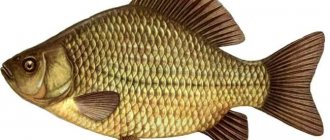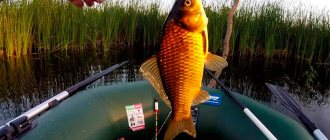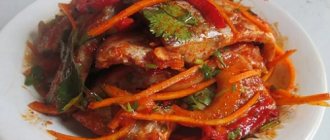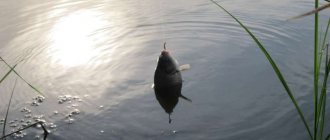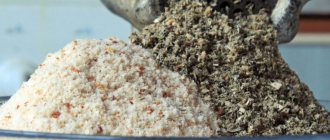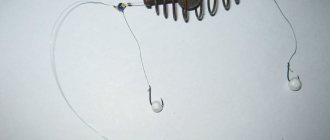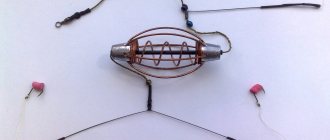What is mastyrka
Fishermen call mastyrka a dough-like bait for crucian carp and other varieties of river and lake fish. The peculiarity of this bait is that the required components for its preparation are ingredients of plant origin. Thus, a crucian carp “dish” can be prepared using semolina, peas, corn, potatoes, garlic, flour and cereals.
Did you know? In some countries of Central Africa, fishing enthusiasts go to reservoirs not with
fishing rods, but with... shovels.
They hunt protoptera - a fish that, during dry periods, goes deep into the silt, where it can survive for a long time without water, and catching it involves digging it out. The advantage of the mastyrka is that it sits firmly on the hook and will not fall off it even when casting over long distances. The whole secret is in following the subtleties of preparation: if you consistently and carefully follow the recipe, the bait will be viscosity, thickness and elasticity.
Mastyrka composition
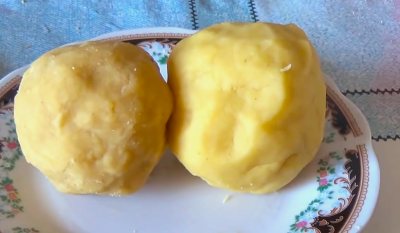
Whatever recipe is used, semolina and peas . If desired, you can additionally include:
- honey;
- sugar;
- food colorings;
- vegetable oil.
These components will give the bait a smell that will certainly arouse the interest of the fish.
How to prepare mastyrka for catching crucian carp at different times of the year
Fishing for crucian carp is most effective in the spring before the start of the spawning period. The fact is that fish in the spring are very voracious, which is essential for them after a long winter fast, and will bite on almost all types of bait, but will give preference to components of animal origin. With the onset of May, crucian carp begins to be more demanding of the diet prepared by fishermen, so this month it is preferable to combine plant and animal food for it, for example, prepare mastyrka with maggots, worms, bloodworms.
Important! As for the ingredients for preparing bait, regardless of the time of year, take several varieties with you to the river. In summer, bait with garlic, corn juice and other flavors is especially popular.
In summer, crucian carp becomes completely capricious. This period is considered to be the time of the “summer diet”: the crucian carp switches exclusively to a plant diet, that is, the time has come to prepare only mastyrka for it, preferably with the addition of various flavorings.
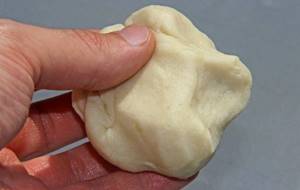
With the autumn cooling, the taste preferences of this fish are again inclined towards food of animal origin, so you can try to combine different versions of dough-like bait and animal components.
It is generally accepted that in winter crucian carp hibernate: it becomes motionless, its vital processes slow down, and its appetites are dulled. But this depends on the habitat of the fish. In shallow bodies of water, where the water freezes right down to the bottom, this is indeed the case. If we are talking about deep-water rivers or lakes, then fishing for crucian carp is quite possible here. It is preferable to provide him with bloodworms as bait. One of the most common varieties of mastyrka is potato mastyrka.
We recommend learning how to catch crucian carp in windy weather.
You can prepare it according to several recipes.
Recipe No. 1:
- Boiled potatoes, about 6 pieces (you need to boil them for this mastyrka in their uniforms), grind them in a meat grinder with a piece of whole rye bread.
- In a separate container, prepare porridge from a glass of corn grits.
- Pour the bread and potato mixture over the porridge and pass everything through the meat grinder again.
- Then knead this kind of dough until it stops sticking to your hands.
- Add 1 tbsp to the bait. l. sunflower oil and mash a little more.
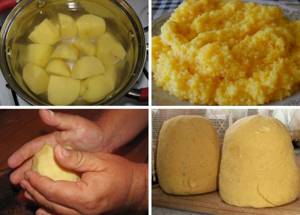
Recipe No. 2:
- Boil the potatoes and mash them (about 4 potatoes).
- In a separate container, do the same with the peas.
- Mix potato and pea dishes in a ratio of 2:3.
- Pour 1 tbsp into the mixture. l. vegetable oil.
- Then add semolina or flour to the mastyrka (determine the quantity at your own discretion). This should be done so that the bait reaches the consistency of a tight dough.
Important! Sprinkle flour on the board to prevent the bait from sticking to it.
The preparation procedure is as follows:
- Wash the pea grains well.
- Pour cold water over the peas until it completely covers them.
- Cook the pea puree over low heat (the peas should dissolve on their own when ready).
- Gradually add semolina to the puree and mix the mixture thoroughly so that the semolina does not form lumps.
- Pour the pea-semolina puree onto a wooden board and leave to cool.
- Add the yolk and sunflower oil to the mastyrka and mix everything thoroughly.
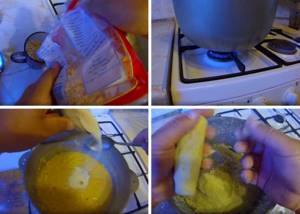
peas, about 2 tbsp. water, 1 tbsp. l. unrefined sunflower oil, half a glass of semolina and one egg yolk. Pea and semolina mastyrka can be prepared with the addition of honey, food coloring and other ingredients.
Did you know? In 1959, fisherman Elf Dian in one of the bays of South Australia caught a
man-eating white shark with a fishing rod: its weight was 1208 kg and its length was
5.14
m. To pull such prey out of the water, the fisherman needed the help of several people, and he himself the process lasted about 4 hours.
The preparation procedure consists of the following steps:
- Pour 200 g of well-washed peas with water and leave to swell overnight.
- Place the peas on the stove and bring to a boil, then reduce the heat and simmer until tender.
- Mash the peas without removing from the heat.
- Add 1 tsp to the dish. sugar, honey and dye, preferably orange (too bright colors can scare away the fish).
- Mix the resulting mass thoroughly and remove from the stove.
- To the cooled mixture you need to add a handful of flour and two handfuls of semolina, as well as 1 tbsp. l. sunflower oil. Mix everything well.
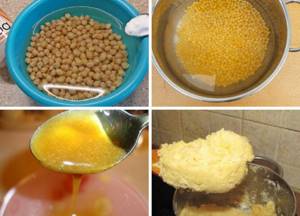
Mastyrka is also prepared from pea flour, which you can easily make yourself. To do this, you need to pour the peas into a coffee grinder and grind them, then sift the flour through a sieve.
Read also the description and characteristics of silver crucian carp.
The preparation procedure is quite simple:
- Pour the resulting product into a pan and add semolina in a 1:1 ratio.
- Fill the container with water until it completely covers everything.
- Add food coloring - yellow or orange - to the future mastyrka. Take it on the tip of the knife.
- Mix the resulting mixture thoroughly.
- Only now is the time to put the “crucian carp food” on the fire. It will be prepared in a water bath. To do this, take a large saucepan and fill it halfway with water. Cover the small container with the cereal mixture with a lid and place it in the larger one.
- If everything is done correctly, then after 25 minutes you can take out the “dish” and start kneading it until you get a consistency similar to plasticine.
- Add 1 tbsp to the finished mastyrka. l. unrefined sunflower oil and some flavoring (for example, anise drops).
Video: mastyrka made from pea flour

One of the simplest and fastest ways to prepare mastyrka is from corn grits, or rather, from flour made from it:
- The beans need to be ground in a coffee grinder into powder, which will take 1 liter.
- Pour 1 liter of water into a clean saucepan, put on fire and bring to a boil.
- Gradually pour the corn flour into the container, stirring thoroughly so that no lumps form.
- After all the corn components have been poured out, turn off the heat and continue stirring for another 5 minutes.
- Then you need to remove the mask from the stove and let it cool. Its consistency will be a little softer than plasticine.
You will be interested to know how crucian carp differs from carp and other fish.
Among the popular varieties of mastyrka is pea with semolina and garlic.
The procedure for its preparation consists of the following steps:
- Soak 2 cups of peas for 10-12 hours.
- After the specified time, cook thick pea porridge.
- Add 3 cups of semolina to the peas, but do this gradually, mixing thoroughly so that no lumps form.
- Remove the mastyrka from the heat and knead it well until it stops sticking to your hands.
- Add about 0.5 cups of flour to the almost finished dish, which will give the bait a special aroma and the desired thickness.
- Add 2-3 cloves of chopped garlic to the bait as a flavoring agent.
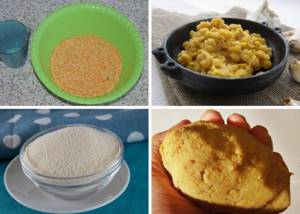
Mastyrka from millet and pearl barley
Another recipe for making mastyrka involves using it not only as a bait, but also as bait in a spring or nipple. To prepare this mastyrka you need to take:
- 400 grams of peas;
- 100 grams of millet;
- 100 grams of pearl barley;
- 100 grams of semolina;
- 50 grams of flavoring;
- 50 grams of dye (optional).
First you need to mix millet with pearl barley and semolina and cook this mass until completely cooked (it should be soft and practically free of grains). Next, cook the peas until they become soft. Boiled cereals, flavoring and coloring are added to the peas, and the whole mass is ground through a coarse sieve (4-6 mm).
The dough is kneaded until it becomes soft clay, divided into three parts, wrapped in a wet cloth and placed in the refrigerator. If during kneading it is not possible to achieve a dense mass, it is necessary to add a little wheat or corn flour until the desired result is achieved.
Important! Any mastyrka for crucian carp should be dense, because if necessary, it can be softened by adding water. But it is unlikely that it will be possible to make liquid bait dense in a reservoir, so you need to strictly adhere to the manufacturing recommendations and the ratio of components.
Semolina is the connecting link, and the semolina itself should have the aroma of peas, honey, or a specially added flavoring. In the spring months, mastyrka with vanilla or anise drops is especially effective, but in the summer honey, garlic and thyme work great.
Recommended reading: Fish first courses

Features of microwave cooking
Mastyrka can be easily and quickly prepared in the microwave, and not just on the stove. For example, if we are talking about bait made from pea flour and semolina.
We advise you to find out at what atmospheric pressure crucian carp bites best.
To do this you need:
- Mix the necessary ingredients in a special bowl that can be cooked in a microwave oven.
- Pour boiling water over the semolina-pea mixture.
- Mix well until smooth and microwave for 3 minutes.
- Add 1 tbsp to the mastyrka. l. sunflower oil and honey.
- Finally, the bait must be kneaded well with your hands.
Video: mashing in the microwave
Fast way
How to prepare mastyrka for catching crucian carp very quickly? To do this, you will need a microwave, as well as a coffee grinder or blender for grinding peas.
- Grind half a glass of peas in a coffee grinder to flour.
- Add about half the volume of semolina porridge to the peas.
- Stir, pour into a glass filled with water about two-thirds.
- Stir until it becomes a liquid paste.
- Place the glass in the microwave on the hottest setting. Cooking time depends on the specific microwave and is determined experimentally, usually from 2 to 5 minutes.
- Spread the pulp out of the glass and cool slightly.
- When the hand can tolerate the temperature, knead thoroughly.
Victoria Leshchenko
I've been working hard in the fishing tackle department for the past six years. I can help you assemble almost any gear.
Ask a Question
This method saves time. Usually they try to prepare small volumes purely for bait or right before fishing for crucian carp. You need to add some flavorings or flavoring additives directly to the water before adding the dry composition.
How to store it correctly
When storing mastyrka, you must be guided by the basic rule - do not let the bait dry out. To do this, it can be placed in a special airtight container, a vacuum container, a “string” bag or regular cling film and placed in the refrigerator, where it will remain suitable for fish consumption for no longer than three days.
Important! The mastyrka should be defrosted exclusively on the bottom shelf of the refrigerator, since this process must be carried out gradually. Otherwise, such food will simply crumble and become unusable.
The best storage option is freezing. It is recommended to divide the finished fertilizer immediately after preparation and cooling into portions, wrap them in cling film and place them in the freezer. When you decide to go fishing, defrost the required amount of bait.
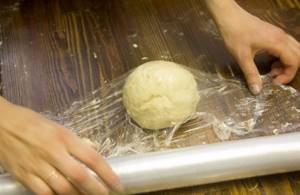
How to save a plant bait
Preparing pea mash takes a long time. If you plan to go fishing regularly, it is better to immediately weld the bait in sufficient quantity. To prevent the product from spoiling, it must be stored correctly:
- roll several medium-sized balls from the cooked mass;
- Wrap each ball individually in clean cotton cloth and then wrap it in plastic wrap;
- Place the balls packed in this way into a plastic bag, seal it tightly and put it in the freezer.
5-6 hours before going fishing, transfer the required amount of mastyrka to the refrigerator shelf. The plant attachment can be stored in the freezer for several months.
Making mastyrka with your own hands is a labor-intensive process, but profitable both in material terms and in terms of the quality of the nozzle. Store-bought does not always meet the specified requirements.
Vegetable bait is usually used for a float fishing rod. It is also suitable for spinning: a properly prepared mastyrka holds well on the hook during long casts.
What fishing gear to choose
You need to choose gear for catching crucian carp depending on where you are going to fish. Thus, fishing on lakes with spacious water areas and large rivers is most effectively done with the help of a feeder, which you can use from early spring to late autumn. But it is worth remembering that during the spawning period, fishing with such gear will be unproductive, since at this time the fish quickly moves from place to place.
Did you know? In 1894, fisherman Walter Kammerow threw a tackle weighing 32 kg into the sea over a distance of 174.5 m, which is considered a world record.
In overgrown reservoirs or ponds with many fallen trees, it is better to catch crucian carp with a float rod. The same equipment will be most suitable for fishing from a boat. You can take a fishing rod with a large rod for long casts. This gear is especially effective for fishing in early spring: hungry crucian carp during this period, in search of food, go close to the shore, where the water warms up faster and the ice melts. They hide near large stones, reeds and snags.
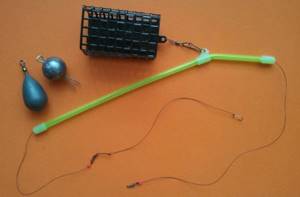
Bottom tackle is excellent for fishing in medium and large lakes, as well as in ponds and rivers with a powerful current. But before casting, study the bottom topography and make sure that the tackle does not get caught on algae, snags, or bushes, because this can lead to its breakage.
The famous mastyrka from Mikhalych
The bait according to the recipe of the well-known video blogger Mikhalych is considered among fishermen to be the most catchy and versatile. It can be hung on a hook or used in feeders.
You will need: 7 glasses of water, 3 glasses of split peas, 2 glasses of semolina, 1/5 tsp. cinnamon, 2-3 tbsp. l. granulated sugar.
What to do with all this:
- pour water into a saucepan and let it boil;
- add peas, cook with regular stirring until tender;
- add sugar;
- mix a glass of semolina with cinnamon, gradually pour into pea porridge;
- Remove the pan from the stove and use a masher to thoroughly mash the mass until smooth;
- add a second glass of semolina in small portions, continuing to work with the masher.
When the mixture begins to resemble a thick dough, leave the pan with the mastyr to cool. During this time, the semolina will swell even more. All you have to do is knead the elastic mass with your hands and roll it into balls or sausages, depending on your fishing needs.
You can familiarize yourself with the step-by-step preparation of mastyrka from Mikhalych by watching this video:
How to properly place a mastyrka on a hook
To secure the mastyrka on the hook, you need to mold it into a dense figure - a ball, a tiny cylinder imitating the shape of a maggot, a drop - and then attach it. When baiting, make sure that the tip of the hook is not visible. If you notice idle bites, then you should make the balls a little smaller. If you combine mastyrka with animal components, first plant a maggot or worm, and then bait, covering the sting with it.
We recommend learning how to catch carp using a float rod.
Mastyrka for feeder
Usually the mastyrka is used for attachment. It is also suitable for fishing for carp using the method, and can be used when fishing with a banjo or with a spring. This paste is not suitable for a feeder or as primary feeding; it is too thick, does not wash out of the feeder, and does not immediately form a large stain on the bottom. There is an option for special pea bait. First, do everything as in the classic cooking method: cover the peas and cook them for about 25 minutes.
After this, you can take out a small part of the peas and use it to prepare regular mastyrka for crucian carp tackle. The remaining portion of 4 cups of peas is filled with two cups of millet and a cup of corn grits. Keep all this on the fire for about 5 minutes, stirring constantly. Then close the cauldron with a lid, remove from heat and let it brew for about 20 minutes. When everything is ready, bring it to the desired consistency by adding breadcrumbs. The bait balls should stick together well, but will disintegrate in the water and give a good trail of food. Thus, you can prepare both bait and bait for the feeder.
Techniques and tactics of fishing with mastyrka depending on the season
It is preferable to catch crucian carp using mastyrka from May until the onset of autumn. So, in the last month of spring, he will prefer “sandwiches” with plant and animal ingredients. In summer, only mastyrka will serve as bait. In the first autumn month, you will again have to return to the so-called sandwiches. You can attach the mastyrka to the feeder, to bottom tackle, and to float rods. The main thing is to prepare and plant it correctly.
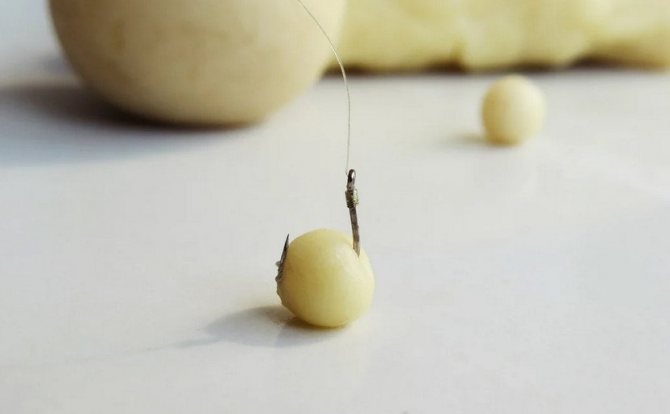
Bait balls can be thrown into the water just like that, without baiting. For example, 2-3 pieces will lure crucian carp to the fishing spot. Every subsequent hour you can put one ball into the reservoir without fear that the fish will get enough and leave. Mastyrka has an attractive aroma, but not nutritional value, so the crucian carp will gather at the fishing site and will bite well.
What do crucian carp bite on?
Various baits can be used to catch crucian carp, and in particular:
- mastyrka;
- dung and earthworm;
- maggot;
- corn;
- peas;
- pearl barley;
- bloodworm.
In some reservoirs, crucian carp are successfully caught even with foam balls, but in this case the correct choice of bait plays a big role. And despite the fact that the main attracting factor to the fishing spot is bait, when fishing for crucian carp the bait plays an equally important role.
The peculiarities of the mouthparts of this fish force it to suck up the bait, and therefore the mastyr is the most effective of them. It is recommended to use the mask at any time of the year and on any body of water, since this attachment is truly universal. Even in winter, when crucian carp very actively “respond” to animal baits, since they are rich in protein, properly prepared mastyrka also shows excellent results, and you will always have a catch.
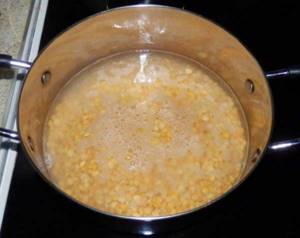
Advantages and disadvantages of catching crucian carp using mastyrka
- Among the advantages of catching crucian carp with a mask, the following are worth highlighting:
- high efficiency - thanks to this bait you can bring home a lot of fish;
- simplicity and economy: preparing such bait does not require a lot of effort and material investments from you - all the ingredients are always in the kitchen of any home and are inexpensive;
- the ability to easily vary the size of the bait on the hook;
- responsive reaction of crucian carp to the odors that the bait spreads;
- convenience : when hooking, the mastyrka easily comes off the hook and does not interfere with hooking a crucian carp;
- productivity : even if the ball falls off, it still attracts fish with its aroma, that is, it is functional.
Pay attention to the information on how to prepare wheat for crucian carp fishing.
Among the few disadvantages is the fact that mastyrka is ineffective for catching crucian carp in reservoirs with high currents, since it is easily washed away by water. It is also worth studying the taste preferences of fish, since crucian carp will refuse plant foods during the period when they need a diet of animal origin. It is also worth remembering that the bait attracts not only crucian carp, but also various small fish that will happily feast on it.
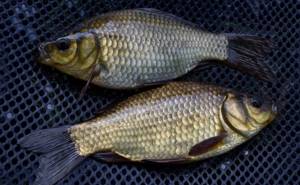
As you can see, in order to get effective, good and high-quality bait for crucian carp fishing, it is not at all necessary to go to a specialized store. You can successfully prepare mastyrka at home, especially since this process does not require special skills, money, and is not labor-intensive. The main thing is to consistently adhere to the preparation procedure and follow the rules for storing bait. And you are guaranteed a rich catch of crucian carp.
Mastyrka storage
It is not always possible for a fisherman to prepare fresh mastyrka before going to a pond. After all, spontaneous trips also happen when there is simply not enough time. Some people buy a special shelf-stable store-bought mask, but often it does not show the expected results.
To always have mastyrka on hand, you need to prepare it. To do this, the prepared mass is divided into portions, packed in sealed bags and stored in the freezer. The disadvantage of this method is that the resulting nozzle loses its aroma in comparison with freshly prepared one.
The second option is that the fisherman prepares a “semi-finished product” - pea puree. We put it in bags or plastic cups and put it in the freezer. Then, before fishing, all that remains is to finish cooking the mastyrka, adding semolina and flavorings.
Mastyrka recipe
The easiest way is to prepare the bait yourself. Before making mastyrka for crucian carp, you need to prepare all the components. The main ingredient when preparing bait is peas. The quality of the dough-like product is important for fishing.
There are recommendations for proper preparation of the main ingredient:
- when using young peas, you just need to grind the product and start cooking;
- dried peas should be soaked in cold water and left to “swell” overnight;
- pea mastyrka for crucian carp can be prepared from a canned product, for this you need to pour boiling water over the peas;
- old peas are soaked for several days and twisted through a meat grinder.
Cooking pea mastyrka for crucian carp is impossible without adding semolina. Any bait is prepared on the basis of water. Some experts add eggs to the pea dough. Thanks to this component, the color of the bait becomes more yellowish, and the food becomes higher in calories.
There are recipes for mastyrka for crucian carp that contain flour.
The classic preparation involves using the following ingredients:
- peas;
- sunflower oil;
- semolina;
- dyes/flavors;
- sugar.
You can also add honey and other ingredients to the bait. Let's take a closer look at how to cook mastyrka for crucian carp.
There are many ways to prepare mastyrka
Classic pea mastyrka

Ingredients:
- Peas – 1 cup
- Semolina – from 1/3 to 1/2 cup
- Boiling water
To prepare mastyrka, you need to take yellow, peeled peas, preferably of good quality, that is, the kind you would use for soup or porridge for yourself. Even the best mastyrka recipe made from poor raw materials will not bring the expected result.
- Pour water over the peas and leave for several hours to swell. It is better to take an aluminum pan in which the pea butter will be cooked; a three-liter pan will be enough.
- After the peas have swollen, drain the water and rinse the peas. This must be done so that there is less foam during cooking.
- Now you need to add water to the peas and cook the mastyrka. The water should cover two fingers of the peas.
- As soon as the water boils, the foam must be removed. Cooking time – up to 1 hour.
- After an hour, drain the water and continue to cook the peas over very low heat, stirring continuously so as not to burn. This can be done using a masher, while simultaneously kneading the mass. Cooking mastyrka from peas occurs only on low heat!
- When the peas start to “puff”, it’s time to add the semolina. This needs to be done gradually: add a spoon, stir, add again, stir again. And so on until you get a consistency similar to soft dough. At this stage, you no longer need to stir, but knead intensively, and constantly, otherwise it will burn.
- The finished mass should be cooled slightly and passed through a meat grinder.
- All that remains is to knead the pea mash, form it into a ball, pack it in a bag or cling film and you can go fishing.
The more semolina there is, the better the pea mastyrka will stay on the hook, but the catchability of such a bait will decrease. The best option in terms of time is that the mask should be enough for one cast.
If the bait stays on the hook longer, it means that you have gone too far with the semolina and next time you should add less of it.
The amount of semolina depends on the quality of the cereal, and it varies from manufacturer to manufacturer, so it is difficult to give exact proportions.
Proper storage and attachment
The prepared nozzle must be stored correctly so that it does not lose its properties.
Basic recommendations:
- After balls of the required size are made from mastyrka , each of them needs to be wrapped in fabric (cotton or chintz is considered the best), then placed in cling film.
- the finished nozzle exclusively in a dark and cool place.
- Avoid exposure to the sun.
- The ideal storage place is the freezer.
Defrosting is required immediately before fishing , and the product should be transferred from the freezer to the refrigerator shelf. The main thing is not to remove it from the fabric.
There are certain ways to put a mastyrka on a hook. If you stick to them, then such a bait will not slip off at the moment of casting and the crucian carp will not be able to spit it out.
Main methods:
- The ball, made in advance, is placed in such a way that the sting, together with the barb of the hook, is completely hidden in the mask.
- Shape the mastyrka in the form of a maggot (oblong shape) and carefully place it on the hook, while the sting is allowed to come out a little. Note: only small hooks, size No. 1 to No. 3, are suitable for this method.
- Take mastyrka and other bait , for example, maggot or worm. Everything is placed on the hook together, in this case, the mastyrka is closer to the sting.
- A ball is made that fully matches the width of the hook. It is inserted in such a way that the mastyrka is clearly in the neck of the hook, in other words, between the sting and the fore-end.
An important point: a properly prepared and mounted bait can easily withstand 3 or more casts.
Source: lakeking.ru
Preparation
The most common recipes for preparing mastyrka for crucian carp are:
Based on peas and millet with the addition of cinnamon
To prepare you need:
- 0.5 cups of peas;
- 0.5 cups of millet;
- 0.5 cups pearl barley;
- 1 teaspoon cinnamon;
Cooking method:
- The peas are thoroughly washed under running water, transferred to a bowl or other container and filled with cold water for at least 120 minutes.
- Next, the water is drained and the peas are transferred to the pan.
- Millet and pearl barley are also added here , everything is filled with water and put on fire. Tip: the water level should be 3 centimeters higher than that of the cereal.
- After the water boils , you need to reduce the heat and cook for about 40–50 minutes, stirring occasionally. Note: you need to cook until all the grains are completely boiled.
- Once cooking is complete , remove from heat.
- Transfer the resulting pulp into a clean bowl and let cool slightly (for 5–7 minutes).
- Pass the mixture through a blender or fine sieve. Mix again.
- Add cinnamon and mix again.
- Make small balls.
If the mass turns out to be very liquid, then you can add flour to it.
The dye (if any) must be added at the time of the last mixing.
Based on peas and semolina with the addition of honey
To do this you will need to take:
- 1 cup peas;
- 0.5 cups semolina;
- 1 teaspoon honey;
- 1 chicken egg;
- 3 ml vegetable oil;
Cooking method:
- Pre-rinse the peas and soak them in cold water for at least 2 hours.
- Afterwards, drain the water , transfer to a small saucepan, add water again and put on fire.
- When it boils , reduce the heat and cook for 50 minutes.
- Add vegetable oil.
- Next , gradually add semolina, stirring constantly.
- After everything is ready , turn off the heat and transfer the resulting mass to a wooden board.
- for 5-7 minutes .
- Add yolk, vegetable oil and honey. To stir thoroughly.
- Make balls of the desired size.
Based on peas and pearl barley with chocolate
To prepare you need:
- 1 cup peas;
- 0.5 cups pearl barley;
- 50 grams of flour;
- egg yolk;
- dark chocolate (1 teaspoon grated);
- 3 ml vegetable oil;
Cooking method:
- Take peas , rinse them thoroughly, put them in a bowl and cover with water for at least 2 hours.
- Next, drain the water , put the peas and pearl barley in a pan, add cold water.
- Put on the fire , after everything boils, cook for about 60 minutes.
- At the end of cooking , pass everything through a sieve (you can use a blender).
- Transfer the resulting slurry to a wooden board previously sprinkled with flour.
- Let cool (about 5-7 minutes).
- Add the yolk and vegetable oil, mix everything well.
- Take the chocolate and grate it on a coarse grater.
- Add chocolate to the resulting mass and mix again.
- Make small balls.
You can add potatoes, however, experienced fishermen note that large crucian carp are rarely caught for such a product.
Mastyrka is considered ideal when its viscosity is similar to plasticine. It often happens that the result is a very thick mass, then it is advised to add the required amount of pea broth. It is not recommended to add boiled water, since in this case there is a risk that the desired aroma will disappear (or be significantly reduced).
Important tip: To prevent boiled peas and semolina from sticking to a wooden board, it is recommended to sprinkle it with a small amount of flour.
Interesting fact: to make the peas boil faster, you can add baking soda to the pan, just a little bit (literally on the tip of a knife).
Cooking errors
Common mistakes:
- For cooking, use regular tap water. It should be remembered that it contains chlorine, the smell of which can scare away crucian carp, so it is more advisable to take spring or bottled still water.
- The peas are undercooked. Only a completely boiled product can be used to prepare the bait, otherwise nothing will be done.
- Add too much flavoring. If you overdo it, you won’t expect any crucian bites at all. You need to add very little.
- Make the mixture too thick. With this outcome, it may not be possible to make a proper bait out of such a mass. It is better if the prepared gruel is soft, in which case adding the required amount of flour will not be difficult.
- Add a lot of semolina. All ingredients must be in equal proportions or the peas should prevail over the rest. If you add a large amount of semolina, it will cover up the smell of other ingredients, and the crucian carp will not bite.
- Take old peas. The best option is to use fresh product for cooking (only from the garden). Last year's will not cook properly and attract the attention of crucian carp.
- Cooked in the wrong container. It is worth remembering that it is better to prepare mastyrka in an enamel pan.
- Do not soak peas or keep them in water for a long time. In the first case, the product will not be able to be cooked correctly; in the second option, there is a chance that it will ferment (especially if the room is very warm).
- It is assumed that the water completely boils away. If during the cooking process the water begins to boil away, then it is necessary to add it; in this case, you need to add a small amount of hot water (you may need to do this several times).
- Defrost incorrectly. You should not do this in a microwave oven, place the product in the sun, or use other quick defrosting options.
Mastyrka storage
The advantage of mastyrka is that it can be prepared once and then used throughout the season, but for this it needs to be provided with the correct storage conditions. To do this, you need to take blanks of calico fabric (this was discussed at the beginning of the article) measuring 25x25cm. The number of scraps corresponds to the number of rolled balls. Each ball is rolled separately into a piece of calico fabric and placed in a plastic bag, after which it is hermetically sealed. After this, the prepared mastyrka balls are placed in the freezer.
In the evening, before the planned fishing, one ball is taken out of the freezer and placed in the refrigerator, on the bottom shelf. Until the morning it will gradually melt without losing the main characteristics of the mastyrka. Before leaving, the ball is removed from the refrigerator and, in this form, is transported to the fishing spot. During transportation, the temperature of the mask will become equal to the ambient temperature, after which the fabric unfolds and can be used. You can roll it into small balls or cut it into 5x5mm cubes and put it on a hook.
